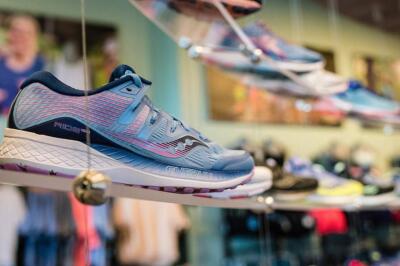How Long Do Running Shoes Last?
Running shoes are tough. But they don't last forever. Running shoes take a beating under our feet, bake on the asphalt and get caked in mud (not to mention sweat).
The outsoles begin to go bald and the cushy foam gets compressed under our weight. When shoes are on their last legs, they lose the ability to protect your feet and joints from the repetitive impact of running, which can lead to increased soreness and injury. So, it’s important to replace your kicks at regular intervals.
How to Extend the Life of Running Shoes 
Even though running shoes will eventually wear out, you don’t want to send them into an early retirement. Like making a sports bra last or preventing running injuries, you’ll get more miles out of your running shoes if you take care of them properly.
- Own at least two pairs of shoes. If you run in just one pair of shoes at a time, the pair shoulders all the weight of your running. But rotating multiple pairs of quality shoes distributes the stress you put them through, so they all last longer.
- Dry them out. You shoes will eventually get wet, whether it's an unexpected downpour or you sweat until they're soaked. After that happens, it’s important to dry your shoes out to keep them in top shape (and funk-free). Protip: Stuff your shoes with newspaper to absorb moisture and set them somewhere to air-dry. The heat of the dryer can damage your shoes.
- Clean them up. Like running in the rain, your shoes will also probably encounter mud or dirt on your runs. Dirt can be abrasive to the shoe’s upper, causing it to wear out prematurely.
- Run on the proper surface. Road running shoes were made to run on pavement, and trail running shoes were meant for the trail. Your road shoes won’t hold up to the abuses of the trail, and the lugs on your trail shoes will get worn down more quickly on rough concrete.
 How to Tell if Running Shoes are Worn Out
How to Tell if Running Shoes are Worn Out
Sometimes the eyeball test will tell you all you need to know about the age of your shoes, but other times worn out shoes might not be so obvious. If your shoes aren’t telling you they’re ready to be retired, your body might provide clues.
Here are some signs that your running shoes are ready for a slower life of mowing the lawn:
- Your shoes will feel flat. The bouncy midsole foam in a pair of new shoes will absorb impact associated with running, saving your feet and joints from taking a pounding. As your shoes age, though, the foam loses some of its ability to rebound, like if you put a brick on top of a marshmallow.
- Nagging aches and pains. Hard workouts or increased mileage can make you feel sore the next day, but if little pains persist even after a normal run, it might be time for a refresh.
- Worn soles. The outsoles of your running shoes have tread just like the tires on your car, which helps cushion your landings and grip the pavement. But the ground is abrasive, especially if you primarily run on concrete and asphalt. If your soles sport bald patches and excessive wear, they won’t serve you as well as a new pair.
- Uneven wear. If your worn soles are uneven, this can signal an even greater problem than just needing new shoes. It could mean you need different types of shoes to better support your feet. If that's the case, take them with you when you go to get fitted for your next pair.
How Many Miles Do Running Shoes Last? 
Tire companies recommend replacing many popular tires around 60,000 miles, and your engine oil should be swapped when you’ve driven 5,000 miles. But what about your running shoes?
If you keep track of the miles you run in each pair, most high-quality running shoes should be replaced between 300 and 500 miles, though that number is lower for race-day shoes, which are designed to be lighter and faster. Top running shoe brands recommend those intervals based on when the materials start to deteriorate, even if the signs aren’t easily visible.
So, if your old slippers are creeping up in miles, it might be time to choose a new pair of running shoes.
Connect With Us
see the latest from Fleet Feet Raleigh